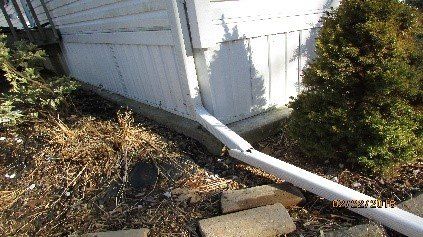Tips from the Inspector

VEGETATION
- Vegetation too close or in contact with the structure can trap moisture, provide a pathway for insects and damage building materials. Bushes, shrubs, etc. should be trimmed back at least 2-3 feet away from the structure. It’s recommended that tree limbs be kept at least 10 feet away to prevent abrasion damage and moss growth.
DOWNSPOUTS - Often taken for granted, poor downspouts result in wet basements. All rain water should be directed away from the foundation. In most cases downspouts should be extended 5-6 feet away from the house.
UNDER SINKS
- Home inspectors look under every sink. If there’s been leaks in the past and the cabinet floor is damaged or the pipes are stained/corroded, we will comment on it. Give this cabinet and the pipes a good cleaning, replace or put shelf paper on the cabinet floor if needed.
These tips can help minimize red flags
during the buyer’s home inspection. Best of luck!

Home inspections are not just for home-buyers! Pre-Sale home inspections make good sense for sellers too.
Some benefits to the seller include:
- Peace of mind. Uncover problems ahead of time.
- Minimize price negotiations and 11th hour surprises.
- Remove obstacles that can interfere with the sale.
- Seller is present for the inspection.
- A clean report can help the seller substantiate a higher asking price.
- The deal is less likely to fall apart.
- Gives you time to make repairs and get fair estimates, if needed.
- Buyer may waive the inspection contingency.

Avoid the disaster of a flooded basement!
If you haven't already disconnected your hoses from the spigots, do it now! Failure to do so could be disastrous! Make sure you remove any accessories attached to the hose connection and shut off the water inside. Look at the basement ceiling where the hose plumbing exits the foundation. Follow it and there should be a shutoff valve nearby.
If you don't have freeze-proof hose bibs (spigots), it may be a good idea to install them. If your not sure if yours are freeze-proof, look for the circular shaped vacuum break on top. Freeze proof hose bibs come in different lengths and extend through the foundation where the valve mechanism controls water flow in the warm inside of the basement. The vacuum break allows any residual water to drain out of the length of pipe.
Even with the freeze-proof type of hose bib you must remove the hose and accessories . They will trap water that can freeze and burst the pipes. A flooded basement on a freezing day is (as my kids would say) the worst day ever . Sometimes you won't know if there's a problem until you turn the water back on in the spring.
Be sure to check your hoses before it's too late!
If you haven't already disconnected your hoses from the spigots, do it now! Failure to do so could be disastrous! Make sure you remove any accessories attached to the hose connection and shut off the water inside. Look at the basement ceiling where the hose plumbing exits the foundation. Follow it and there should be a shutoff valve nearby.
If you don't have freeze-proof hose bibs (spigots), it may be a good idea to install them. If your not sure if yours are freeze-proof, look for the circular shaped vacuum break on top. Freeze proof hose bibs come in different lengths and extend through the foundation where the valve mechanism controls water flow in the warm inside of the basement. The vacuum break allows any residual water to drain out of the length of pipe.
Even with the freeze-proof type of hose bib you must remove the hose and accessories . They will trap water that can freeze and burst the pipes. A flooded basement on a freezing day is (as my kids would say) the worst day ever . Sometimes you won't know if there's a problem until you turn the water back on in the spring.
Be sure to check your hoses before it's too late!


